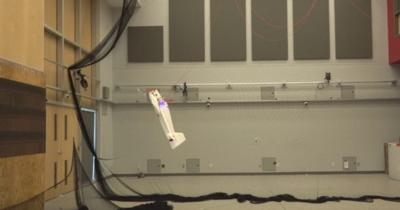Thu, Sep 07, 2017
Uses Microspines To Attach To Rough Surfaces
One of the big advantages to multi-rotor drones is their ability to take off and land vertically. But even a small landing spot might not always be available if needed. Enter the Multimodal Autonomous Drone (S-MAD) developed by researchers at the University of Sherbrooke in Canada.

S-MAD is a fixed-wing drone with the ability to land on a vertical surface like a wall or tree and stay there. To develop the technique, engineers studied how birds take off and land and installed similar mechanisms on the aircraft. They have achieved a 100 percent success rate for landing on vertical surfaces, according to a report appearing on Engadget.
According to an excerpt from the abstract of a scholarly paper on the Createk Design Lab YouTube site, the company says the S-MAD "uses a thrust-assisted pitch-up maneuver to slow down rapidly before touchdown. Microspines are used to cling to rough walls, while strictly onboard sensing is used for control. The effect of thrust on the suspension’s landing envelope is analyzed and a simple vertical velocity controller is proposed to create smooth and robust descents towards a wall. Multiple landings are performed over a range of flight conditions."
In its YouTube video, Createk says the aircraft could have applications such as monitoring areas hit by earthquakes, as well as the inspection of buildings, bridges and other infrastructure.
To land, the aircraft uses sensors to detect the wall, and then executes a rapid pitch-up maneuver to present the microspines to the landing surface. Power is added on final approach to maintain vertical speed and pitch angle. The company says over 30,000 simulations were run to perfect the technique.
To take off, the S-MAD develops enough power to hang from its prop while the microspine feet disengage, and then return the aircraft to a horizontal flight profile.
Createk and the university are continuing to refine the aircraft, and no commercial launch has been discussed.
(Image from YouTube video)
More News
Aero Linx: JAARS Nearly 1.5 billion people, using more than 5,500 languages, do not have a full Bible in their first language. Many of these people live in the most remote parts of>[...]
'Airplane Bounced Twice On The Grass Runway, Resulting In The Nose Wheel Separating From The Airplane...' Analysis: The pilot reported, “upon touchdown, the plane jumped back>[...]
"Burt is best known to the public for his historic designs of SpaceShipOne, Voyager, and GlobalFlyer, but for EAA members and aviation aficionados, his unique concepts began more t>[...]
"Polaris Dawn, the first of the program’s three human spaceflight missions, is targeted to launch to orbit no earlier than summer 2024. During the five-day mission, the crew >[...]
There Are SO Many Ways To Get YOUR Aero-News! It’s been a while since we have reminded everyone about all the ways we offer your daily dose of aviation news on-the-go...so he>[...]
 ANN's Daily Aero-Linx (05.04.24)
ANN's Daily Aero-Linx (05.04.24) NTSB Final Report: Quest Aircraft Co Inc Kodiak 100
NTSB Final Report: Quest Aircraft Co Inc Kodiak 100 Aero-News: Quote of the Day (05.04.24)
Aero-News: Quote of the Day (05.04.24) Aero-News: Quote of the Day (05.05.24)
Aero-News: Quote of the Day (05.05.24) Read/Watch/Listen... ANN Does It All
Read/Watch/Listen... ANN Does It All



